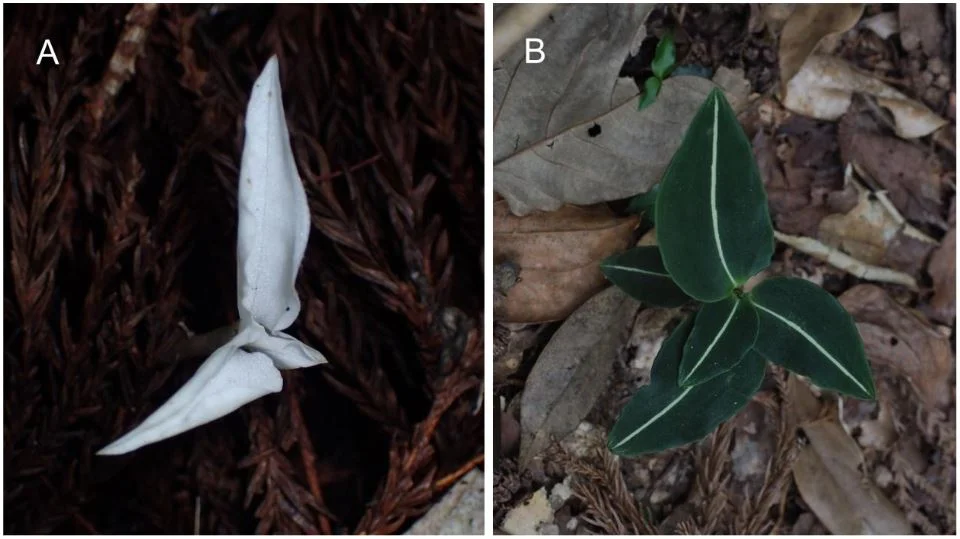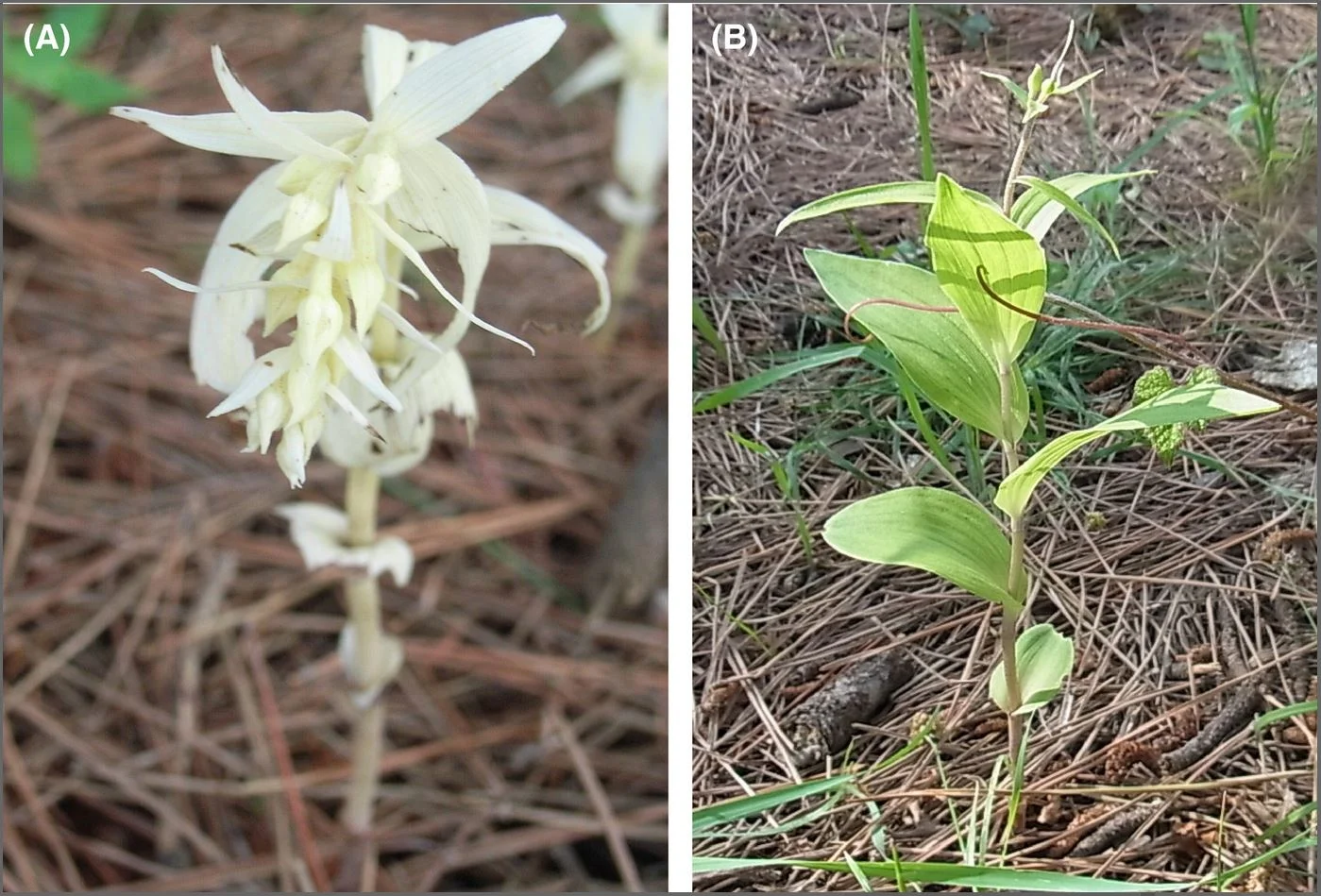A) Albino and (B) green individual of Goodyera velutina.
The botanical world is synonymous with the idea of photosynthesis. Plants take in carbon dioxide and water and utilize light to make their own food. However, not all plants make a living this way. There are many different species of plants that have evolved a parasitic lifestyle to one degree or another. Some of my favorites are those that parasitize mycorrhizal fungi. We call these plants “mycoheterotrophs” and they are fascinating to say the least. Orchids are especially prone to this strategy, with over 1% of all known species having completely lost the ability to photosynthesize.
Our knowledge of the mycoheterotrophic strategy is fragmentary at best. We still don’t fully understand things like how the plants obtain what they need from the fungus nor how they are able to maintain their parasitic lifestyle without the fungus catching on and rejecting the one-sided partnership. This is not to say we know nothing. In fact, as technologies advance, we are unlocking at least some of the mysteries of mycoheterotrophic plants. Some of the best advances come from studying mutant, albino orchids. To understand how, we have to take a closer look at the “average” orchid lifestyle.
Orchids in general make great candidates for understanding the evolution of mycoheterotrophy because all of them start their lives as parasites. Orchids produce some of the smallest seeds in the plant kingdom and without the help of mycorrhizal fungi, they would never be able to germinate. For much of their early life, orchids rely on fungi to provide them with both their mineral and carbohydrate needs. Only after the orchids are large enough to grow leaves will most of them start to give back to their fungal partners in the form of carbohydrates generated from photosynthesis.
Still, many orchids never fully let go of this parasitic lifestyle. This is especially true for orchids living under dense forest canopies. With light in limited supply, many orchids adopt a mixotrophic lifestyle. Essentially this means that although they actively photosynthesize, they nonetheless rely on fungi to provide them with both carbohydrates and minerals. Mixotrphy is likely the most wide-spread orchid strategy and it has been hypothesized that it is also the first step along the path to becoming fully parasitic. This is where the mutant orchids enter the equation.
(A) Albino and (B) green individuals of Epipactis helleborine
Every once in a while, some orchids will germinate and grow into albino versions of their species. Without the ability to produce chlorophyll, these mutants should be destined for a quick death. Such is not the case for many of these orchids. Albino orchids often go on to live full lives, growing and flowering just like their photosynthetic progenitors. Although they do exhibit signs of reduced fitness, the fact that they are able to live at all brings up a lot of questions ready for science to tackle.
Recent investigations into the lives of these albino mutants has revealed some interesting insights into how mycoheterotrophy may have evolved in the first place. By studying the fungal partners of both healthy plants and the albinos, researchers have been able to demonstrate that albinos are doing things a bit differently than their photosynthetic parents. Using isotopes of carbon and nitrogen, scientists are discovering that the albinos have switched their interaction with the fungi in such a way that they more resemble fully mycoheterotrophic orchid species. This is done despite the fact that both albinos and their fully functional parents associate with the same guild of mycorrhizal fungi.
Another interesting difference between albinos and their photosynthetic parents is the fact that the genes involved both antioxidant metabolism and metabolite transfer (mainly carbon in this case) were more active in the albinos than they were in functioning plants. The uptick in gene functioning related to antioxidant metabolism suggests that the mutant plants are undergoing greater oxidative stress than their functional parents. This may have something to do with how the albinos are able to obtain nutrients from their fungal partners. It is thought that mycoheterotrophs actively digest parts of the fungi, which allows them to access the carbon and minerals they need to survive. This process exposes their cells to reactive oxygen compounds that can be very damaging. Antioxidants would help to reduce such damage.
The uptick in genes associated with metabolite transfer was more surprising because it suggests that despite being parasites, the plants are actively transferring substances back to the fungi. It has long been assumed that mycoheterotrophy was a one way street, with fungi transferring nutrients to plants only. These genes now suggest that, at least in some species, such transfer is a two-way street. The exact nature of this two-way transfer remains a mystery and certainly brings up many more questions that must be asked before we can better understand this relationship.
All of this is not to say that such albino mutants are fruitful “next steps” in the evolution of these species. Far from it, in fact. Two things that most albino orchid variants have in common is the fact that they are rare and, of those that have been studied, produce far fewer seeds. There are a lot of anatomical and physiological differences between true mycoheterotrophic species and albino variants and it appears that without those anatomical adaptations, the albinos are a lot less fit than their photosynthetic parents. As authors Selosse and Roy put it:
“non-chlorophyllous variants are likely to represent unique snapshots of failed transitions from mixotrophy to mycoheterotrophy. They are ecological equivalents to mutants in genetics, that is, their dysfunctions might suggest what makes mycoheterotrophy successful. Although their determinism remains unknown, they offer fascinating models for comparing the physiology of mixo- and mycoheterotrophs within similar genetic backgrounds.”
Mutants are strange indeed but with the right kinds of questions and approaches, they have a lot to teach us about ecology, evolution, and life at large.


![[SOURCE]](https://images.squarespace-cdn.com/content/v1/544591e6e4b0135285aeb5b6/1490721649685-7VDQ5S929EILAFUA4HS1/image-asset.png)
